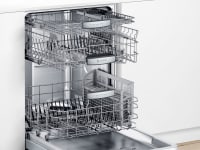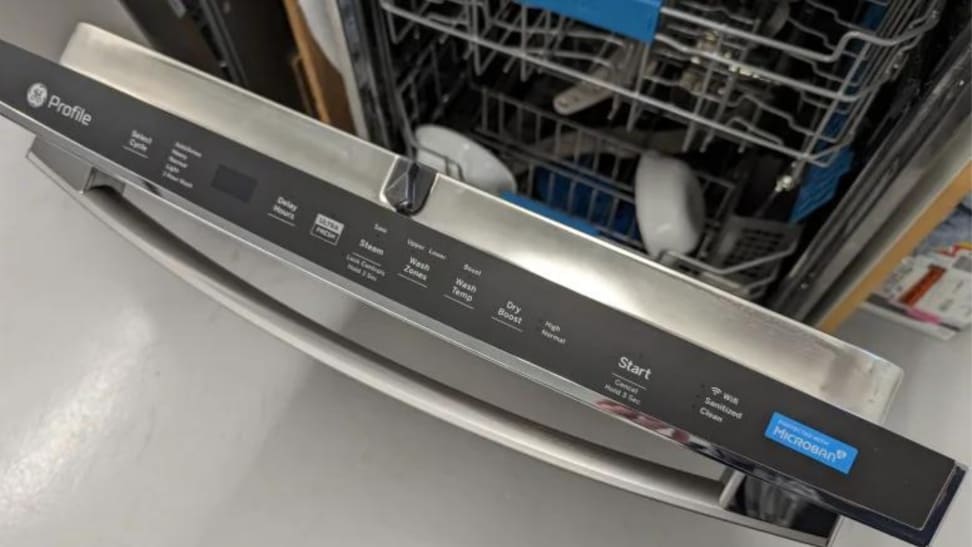 Credit:
Reviewed / David Ellerby
Credit:
Reviewed / David Ellerby
Products are chosen independently by our editors. Purchases made through our links may earn us a commission.
Have you ever stared at your dishwasher's control panel in confusion, wondering what all those cycles mean and whether you should use them? From "Sanitize" and "Eco" to "Sensor" and the maddeningly vague "Normal," it's tough to know the best dishwasher cycle for your situation.
You could consult the manual. Let’s face it, though, if it wasn’t instantly consigned to the recycling, you’ve probably forgotten where it is.
Below we break down the most common cycles and help you choose the best dishwasher settings for your needs.
Normal Cycle
If you're like me, this is probably your go-to choice since you long ago gave up trying to decipher the other options.
According to multiple manufacturers, you should be fine using this setting for "normally soiled dishes"—in other words, dishes and cookware with no baked-on food residue.
The problem with using the Normal cycle as your default is that you may not get the best from your dishwasher.
The main differences between cycles are in the amount of water they use, the water temperature, and how long they take. If you use more water and heat than you need, then you’re wasting money every time you run your dishwasher.
The Normal cycle may be more than you need if you typically have lightly soiled dishes. You should experiment with other cycles that use lower temperatures and less water. If they still give you the cleaning results you need, you’ll save some cash in the long term.
Auto/Sensor/Smart Wash
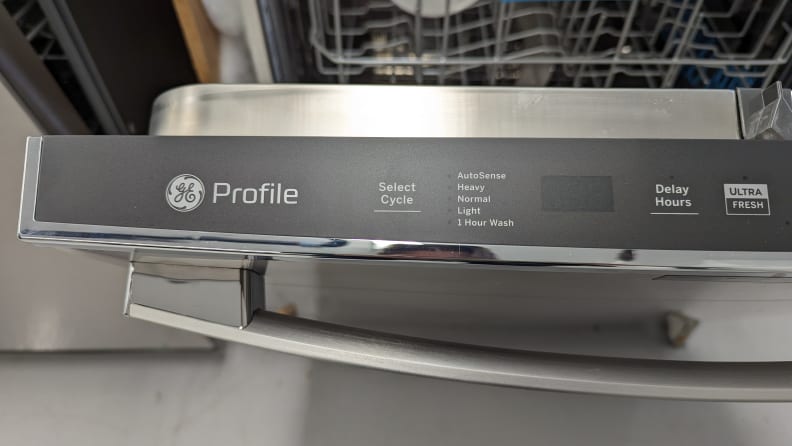
A GE dishwasher with an AutoSense cycle to detect how dirty your dishes are.
This cycle isn’t available in every dishwasher model, but it’s available in almost all of the best dishwashers we’ve tested in our lab. The Auto or Sensor cycle detects how dirty your dishes are and adjusts the heat, intensity, and cycle duration to get them clean.
Different manufacturers choose slightly different names for this cycle. GE calls this cycle AutoSense. Bosch, LG, and Beko go with plain Auto.
Naming aside, these cycles all work in the same way. They detect how much dirt is in the water draining from your dishwasher. Once that water is clean, your dishes should be too, and the cycle shuts down.
The strength of this option is that it should take the guesswork out of choosing a cycle, and by using the right amount of heat and water to get the best results, it will save energy.
The only weakness we can see is that if you had some badly baked-on residue that wasn’t removed, the cycle wouldn’t detect that. That scenario means there’s a small risk of your dishwasher stopping before all your dishes are clean.
Although automatic cycles are helpful for most day-to-day cleaning, they don’t fulfill all the functions available in specialist cycles. Until that happens, other cycle options are here to stay.
Express/Quick/1-Hour Wash
Like the sensor-based Automatic cycle, the one-hour wash cycle also comes with various names. This cycle has one goal, getting your dishes clean as quickly as possible. It's your go-to when you've forgotten to run the wash and need clean plates ASAP.
Although a quick wash cycle sounds good, you should save it for when you need it. To clean quickly, your dishwasher has to dial up its hot water use. The high temperature and the extra energy needed by the heating element can make shorter cycles an inefficient and expensive option.
Pots & Pans/Heavy
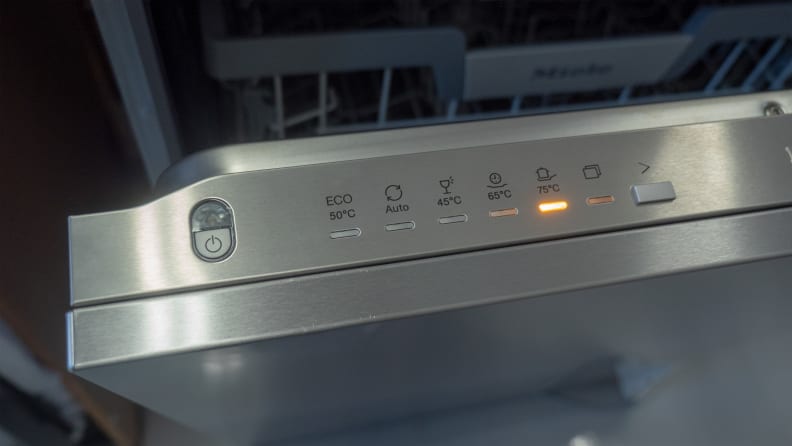
This Miele dishwasher uses a simple image to show the high temperature heavy cycle for pots and pans.
This cycle also goes by several names. GE likes Heavy, and Beko goes with Heavy+.
This cycle is pretty self-explanatory, but here, we'll erase any doubt: Choose this option to clean heavily soiled cookware with baked-on grime. This cycle often uses the most water of any cycle (it varies by machine), but that's necessary to get rid of nasty, baked-on food.
Like the quick wash, this is an expensive cycle to run, so save it for when your pots and pans need it.

The Bosch 800 Series is a near-perfect dishwasher—fast, powerful, and packed with smart features.
Delicate/Light Cycle
This cycle's purpose is also pretty obvious. It's used for cleaning delicate items.
Bosch describes the cycle as for “delicate tableware, cutlery, temperature-sensitive plastics, glasses and stemware.” The gentle action comes from low water temperature and, in some models, a weaker spraying action than in the cycles for plates and cookware.
SaniWash/Anti-Bacterial Cycle
Many dishwashers offer an extra hot sanitizing cycle option. This cycle is based on a standard from NSF International that defines the conditions needed to kill germs.
This standard requires dishwashers with a sanitary cycle to remove 99.999 percent of bacteria from your dishes with a 150 degree Fahrenheit rinse temperature. Not completely germ free, but pretty close.
Miele says it's good for sterilizing things like cutting boards and baby bottles. So if you're worried about germs and bacteria or a raw chicken–covered cutting board, give SaniWash a try.
Rinse Cycle
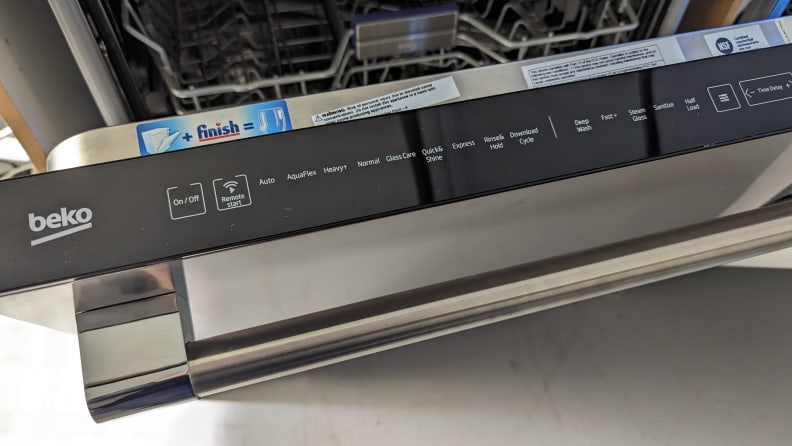
The Rinse & Hold cycle on this Beko prevents dried on stains while you fill the dishwasher.
The Rinse cycle won't directly get your dishes clean and is useful if it takes you a few days to fill up your dishwasher. GE tells us the rinse cycle is for “rinsing partial loads that will be washed later.”
It comes into play if it takes a few days for you to fill up your dishwasher. The rinse cycle isn’t meant to be used with detergent and is designed to avoid dried-on stains and limit bacterial growth.
Eco/Energy Saver Cycle
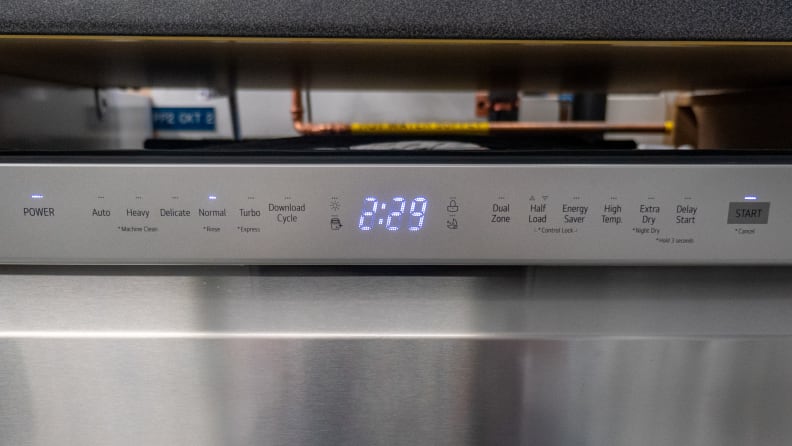
This LG dishwasher has an energy saver option to reduce power consumption.
Nearly all newer dishwashers feature this option. Hot cycles are energy intensive. Eco cycles save energy by using low water and drying temperatures.
The trade-off is that to get acceptable cleaning and drying performance, energy-saving cycles need to run for longer. Despite the extended time, this is still your most energy-efficient option.
If you want to cut your utility costs and are not hurrying to get your clean dishes, you should strongly consider this efficient cycle option.
The product experts at Reviewed have all your shopping needs covered. Follow Reviewed on Facebook, Twitter, Instagram, TikTok, or Flipboard for the latest deals, product reviews, and more.
Prices were accurate at the time this article was published but may change over time.



